- Navigating Your Midlife Crisis: Embracing New Possibilities
- City Raccoons Showing Signs of Domestication
- Mapping the Exposome: Science Broadens Focus to Environmental Disease Triggers
- One Week Less on Social Media Linked to Better Mental Health
- Your Brain Changes in Stages as You Age, Study Finds
- Some Suicide Victims Show No Typical Warning Signs, Study Finds
- ByHeart Formula Faces Lawsuits After Babies Sickened With Botulism
- Switch to Vegan Diet Could Cut Your Greenhouse Gas Emissions in Half
- Regular Bedtime Does Wonders for Blood Pressure
- Dining Alone Could Mean Worse Nutrition for Seniors
Regular Mamograms Might Lead to ‘Overdiagnosis’ of Breast Cancer


Regular mammogram screening for breast cancer might be causing “widespread overdiagnosis,” with some women treated for tumors that would not have caused sickness or death, a new study contends.
Doctors tend to find more small tumors and precancerous lesions in areas where more mammograms take place, researchers found after analyzing county-level data collected by U.S. health officials.
However, the death rate from breast cancer did not appear to drop in the face of increased mammogram rates in those areas, wrote the researchers from Harvard University and Dartmouth.
“The simplest explanation is widespread overdiagnosis, which increases the incidence of small cancers without changing mortality,” the authors argue in the July 6 issue of the journal JAMA Internal Medicine.
But cancer experts said these findings should not lead women to think that mammograms are either unnecessary or potentially harmful.
“My biggest concern with this article is the hint or suggestion that mammography screening does not reduce mortality,” said Dr. Richard Wender, chief cancer control officer for the American Cancer Society. “That question has been decided. There’s no longer any debate about whether mammography saves lives.”
Previous studies have shown that mammography results in at least a 20 percent reduction in breast cancer death rates for women aged 40 and older, said Wender, who was not involved in the study.
However, the new findings show that some women may be able to have less frequent mammograms, said Dr. Harold Burstein, a senior physician with the breast oncology program at the Dana-Farber Cancer Institute in Boston.
“Mammograms are still important, but we still need to figure out which women really need mammograms and on which schedule,” said Burstein, who also serves as an expert for the American Society of Clinical Oncology.
“This study reminds doctors and women that it’s probably worth having a longer discussion about what mammograms can and can’t accomplish, before reflexively deciding that every woman needs a mammogram every year,” added Burstein, who was not part of the study team.
It also highlights the need for research that will help doctors better sort out dangerous breast cancers from other breast tumors that may not need immediate treatment, said Dr. Joann Elmore, a professor of medicine and adjunct professor of epidemiology at the University of Washington in Seattle.
“I want to be able to tell my patients, you do not have the kind of breast cancer that will ever hurt you. You don’t need a mastectomy,” said Elmore, who wrote a commentary on the new study.
The researchers examined medical data for 16 million women aged 40 and older who lived in 547 counties reporting to Surveillance, Epidemiology and End Results cancer registries in 2000. The SEER registries are maintained by the U.S. National Cancer Institute.
Of these women, 53,207 were diagnosed with breast cancer that year and followed for the next 10 years.
The study authors then performed a county-by-county comparison of mammogram rates against both the incidence of breast cancer in 2000 and deaths from breast cancer during the follow-up period. They specifically looked at the percentage of women aged 40 or older who’d had a mammogram in the past two years.
They found that when breast cancer screening increased by 10 percent, doctors diagnosed breast cancer 16 percent more often overall. There also was a 25 percent increase in the diagnosis of small tumors, which measured 2 centimeters or smaller.
But increased screening did not lead to a significant difference in the number of women who died from breast cancer.
Burstein noted that the results may have been affected by focusing solely on women who had a mammogram within the past two years.
“That doesn’t include getting a mammogram every three or four years, or not getting a mammogram at all,” said Burstein. “This is not a study of no mammograms versus mammograms. This is comparing women who get frequent mammograms to everyone else.”
Also, the follow-up may not have been long enough to show the long-term benefits of mammography, Wender said.
“For small tumors, the mortality benefit often doesn’t emerge until you’re 15 or even 20 years out,” he explained. “These small tumors were not destined to cause death until after 15 or 20 years.”
Finally, Burstein said the study relied on large data sets that don’t provide much information about individual patients.
“The study doesn’t have enough granularity to say if this particular woman did not get a mammogram, would she have done as well,” he said.
More information
For more on breast cancer screening, visit the U.S. National Cancer Institute.
Source: HealthDay
Copyright © 2025 HealthDay. All rights reserved.










